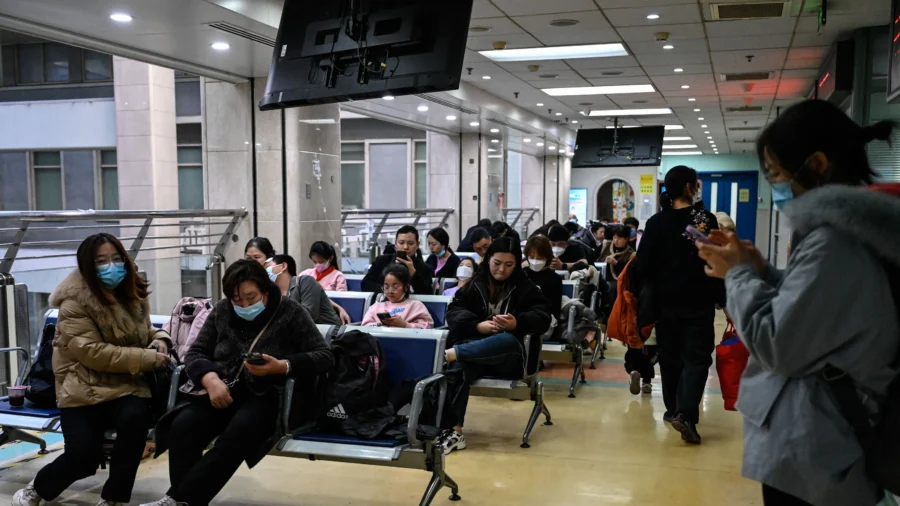A U.S. official sounded the alarm over a “pneumonia outbreak” in northern China that reportedly sent a number of children to local hospitals.
About four years after COVID-19 emerged in China, a number of children have reportedly suffered pneumonia, a fever, or other respiratory issues, according to reports. Hospitals are now reportedly overwhelmed due to the rise in cases, sparking an alert from the World Health Organization as well as a top U.S. official.
“China’s recent pneumonia outbreak raises serious questions, and the World Health Organization is asking them,” said U.S. Ambassador to Japan Rahm Emanuel, the former Obama White House chief of staff, in a post on social media.
“It’s time to abandon COVID deception and delays as transparent and timely information saves lives,” he added, referring to the Chinese Communist Party’s attempts to cover up the extent of the pandemic inside mainland China. “Full cooperation with the international community is not an option, it’s a public health imperative. Will Beijing step up?”
The U.S. ambassador to China, R. Nicholas Burns, hasn’t made a public comment on the matter.
CCP officials have claimed that the mystery outbreak isn’t the result of a new virus, claiming it’s a mix of respiratory illnesses such as mycoplasma pneumoniae, influenza, or RSV.
Mycoplasma pneumoniae is a bacteria that can cause mild infections of the respiratory system, according to the U.S. Centers for Disease Control and Prevention (CDC). However, those bacteria can cause more serious lung infections that require hospital care such as “walking pneumonia,” described as an “atypical” form of pneumonia by health officials.
Taiwanese reports have indicated there were long lines and crowded waiting rooms at a number of child hospitals, including the Beijing Children’s Hospital. And some schools in Beijing reportedly also suspended classes in areas with infection rates.
Social media users who visited Beijing hospitals posted videos of long lines at hospitals. The Epoch Times was not able to confirm the authenticity of the posts.
The situation in China prompted an alert on ProMed, a disease surveillance system that also sounded the alarm in late 2019 in Wuman as COVID-19 emerged on the global scene.
Earlier this week, the World Health Organization (WHO) issued a statement, saying that it is “monitoring data” from CCP-operated surveillance systems.
“Since mid-October 2023, WHO has been monitoring data from Chinese surveillance systems that have been showing an increase in respiratory illness in children in northern China,” the U.N. organization said in a statement. “Today, WHO held a teleconference with Chinese health authorities in which they provided requested data on respiratory illnesses among children in Northern China.”
“The data indicates an increase in outpatient consultations and hospital admissions of children due to Mycoplasma pneumonia since May, and RSV, adenovirus and influenza virus since October,” the WHO continued. “Some of these increases are earlier in the season than historically experienced, but not unexpected given the lifting of COVID-19 restrictions, as similarly experienced in other countries.”
Both the Chinese regime and the WHO have faced criticism over their transparency in reporting the first COVID-19 cases several years ago. There are still numerous questions over the origin of the virus, and Chinese officials have blocked inquiries into the Wuhan Institute of Virology laboratory.
Some researchers have said, however, that people should be cautious over fears of another global pandemic.
Virologist Tom Peacock from Imperial College London, who has closely tracked the emergence of new coronavirus variants, said there were good tools available to “pretty rapidly” pick up emerging influenza or coronaviruses, so it seemed unlikely that this had happened under the radar. ”
The researcher told Reuters that “it may end up being something more mundane or a combination of things … say COVID, flu, RSV.”
China’s recent pneumonia outbreak raises serious questions, and the World Health Organization is asking them. It’s time to abandon COVID deception and delays as transparent and timely information saves lives. Full cooperation with the international community is not an option,…
— ラーム・エマニュエル駐日米国大使 (@USAmbJapan) November 24, 2023
Brian McCloskey, a public health researcher who also advised WHO on COVID-19, told the newswire service: “What we are seeing is WHO’s International Health Regulations system in action”, referring to the rules governing how countries work with WHO on potential outbreaks.”
“I am not going to push the pandemic panic button on the basis of what we know so far, but I will be very keen to see the response to WHO from China and see the WHO’s assessment following that,” he added.
Nonetheless, WHO’s statement said that it recommends “people in China follow measures to reduce the risk of respiratory illness, which include recommended vaccination; keeping distance from people who are ill; staying home when ill; getting tested and medical care as needed; wearing masks as appropriate; ensuring good ventilation; and regular hand-washing.”
The Chinese regime has 24 hours to respond to the WHO under the regulations.
Reuters contributed to this report.
From The Epoch Times

